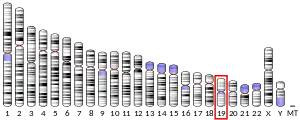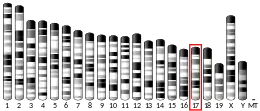LRG1
Leucine-rich alpha-2-glycoprotein 1 is a protein which in humans is encoded by the gene LRG1.[5]
Function
The leucine-rich repeat (LRR) family of proteins, including LRG1, have been shown to be involved in protein-protein interaction, signal transduction, and cell adhesion and development. LRG1 is expressed during granulocyte differentiation.[5][6]
LRG1 has been shown to be involved in promoting neovascularization (new blood vessel growth) through causing a switch in transforming growth factor beta (TGFbeta) signaling in endothelial cells. LRG1 binds to the accessory receptor endoglin and promotes signaling via the ALK1-Smad1/5/8 pathway.[7]
Application
Levels of the LRG protein are markedly elevated in acute appendicitis and therefore could be used as a diagnostic aid.[8]
LRG1 may be a potential therapeutic target for the treatment of diseases where there is aberrant neovascularization.[7]
References
- GRCh38: Ensembl release 89: ENSG00000171236 - Ensembl, May 2017
- GRCm38: Ensembl release 89: ENSMUSG00000037095 - Ensembl, May 2017
- "Human PubMed Reference:". National Center for Biotechnology Information, U.S. National Library of Medicine.
- "Mouse PubMed Reference:". National Center for Biotechnology Information, U.S. National Library of Medicine.
- "Entrez Gene: LRG1 leucine-rich alpha-2-glycoprotein 1".
- O'Donnell LC, Druhan LJ, Avalos BR (September 2002). "Molecular characterization and expression analysis of leucine-rich alpha2-glycoprotein, a novel marker of granulocytic differentiation". J. Leukoc. Biol. 72 (3): 478–85. PMID 12223515.
- Wang X, Abraham S, McKenzie JA, Jeffs N, Swire M, Tripathi VB, Luhmann UF, Lange CA, Zhai Z, Arthur HM, Bainbridge JW, Moss SE, Greenwood J (July 2013). "LRG1 promotes angiogenesis by modulating endothelial TGF-β signalling". Nature. 499 (7458): 306–11. doi:10.1038/nature12345. PMC 3836402. PMID 23868260.
- Vargas IM (2009-06-23). "A urine test for appendicitis?". HarvardScience Press Release. Harvard College. Retrieved 2009-06-25.
Further reading
- Li X, Miyajima M, Jiang C, Arai H (2007). "Expression of TGF-betas and TGF-beta type II receptor in cerebrospinal fluid of patients with idiopathic normal pressure hydrocephalus". Neurosci. Lett. 413 (2): 141–4. doi:10.1016/j.neulet.2006.11.039. PMID 17194537. S2CID 54324280.
- Ramachandran P, Boontheung P, Xie Y, et al. (2006). "Identification of N-linked glycoproteins in human saliva by glycoprotein capture and mass spectrometry". J. Proteome Res. 5 (6): 1493–503. doi:10.1021/pr050492k. PMID 16740002.
- Cummings C, Walder J, Treeful A, Jemmerson R (2006). "Serum leucine-rich alpha-2-glycoprotein-1 binds cytochrome c and inhibits antibody detection of this apoptotic marker in enzyme-linked immunosorbent assay". Apoptosis. 11 (7): 1121–9. doi:10.1007/s10495-006-8159-3. PMID 16699948. S2CID 39838086.
- Liu T, Qian WJ, Gritsenko MA, et al. (2006). "Human plasma N-glycoproteome analysis by immunoaffinity subtraction, hydrazide chemistry, and mass spectrometry". J. Proteome Res. 4 (6): 2070–80. doi:10.1021/pr0502065. PMC 1850943. PMID 16335952.
- Gerhard DS, Wagner L, Feingold EA, et al. (2004). "The status, quality, and expansion of the NIH full-length cDNA project: the Mammalian Gene Collection (MGC)". Genome Res. 14 (10B): 2121–7. doi:10.1101/gr.2596504. PMC 528928. PMID 15489334.
- Yamada S, Ohira M, Horie H, et al. (2004). "Expression profiling and differential screening between hepatoblastomas and the corresponding normal livers: identification of high expression of the PLK1 oncogene as a poor-prognostic indicator of hepatoblastomas". Oncogene. 23 (35): 5901–11. doi:10.1038/sj.onc.1207782. PMID 15221005.
- Bunkenborg J, Pilch BJ, Podtelejnikov AV, Wiśniewski JR (2004). "Screening for N-glycosylated proteins by liquid chromatography mass spectrometry". Proteomics. 4 (2): 454–65. doi:10.1002/pmic.200300556. PMID 14760718.
- Anderson NL, Polanski M, Pieper R, et al. (2004). "The human plasma proteome: a nonredundant list developed by combination of four separate sources". Mol. Cell. Proteomics. 3 (4): 311–26. doi:10.1074/mcp.M300127-MCP200. PMID 14718574.
- Strausberg RL, Feingold EA, Grouse LH, et al. (2003). "Generation and initial analysis of more than 15,000 full-length human and mouse cDNA sequences". Proc. Natl. Acad. Sci. U.S.A. 99 (26): 16899–903. doi:10.1073/pnas.242603899. PMC 139241. PMID 12477932.
- O'Donnell LC, Druhan LJ, Avalos BR (2002). "Molecular characterization and expression analysis of leucine-rich alpha2-glycoprotein, a novel marker of granulocytic differentiation". J. Leukoc. Biol. 72 (3): 478–85. PMID 12223515.
- Saito K, Tanaka T, Kanda H, et al. (2002). "Gene expression profiling of mucosal addressin cell adhesion molecule-1+ high endothelial venule cells (HEV) and identification of a leucine-rich HEV glycoprotein as a HEV marker". J. Immunol. 168 (3): 1050–9. doi:10.4049/jimmunol.168.3.1050. PMID 11801638.
- Takahashi N, Takahashi Y, Putnam FW (1985). "Periodicity of leucine and tandem repetition of a 24-amino acid segment in the primary structure of leucine-rich alpha 2-glycoprotein of human serum". Proc. Natl. Acad. Sci. U.S.A. 82 (7): 1906–10. doi:10.1073/pnas.82.7.1906. PMC 397442. PMID 3856868.
- Andersen JD, Boylan KL, Xue FS, Anderson LB, Witthuhn BA, Higgins L, Skubitz AP (2010). "Identification of candidate biomarkers in ovarian cancer serum by depletion of highly abundant proteins and differential in-gel electrophoresis". Electrophoresis. 31 (4): 599–610. doi:10.1002/elps.200900441. PMC 3520508. PMID 20162585.
This article incorporates text from the United States National Library of Medicine, which is in the public domain.



